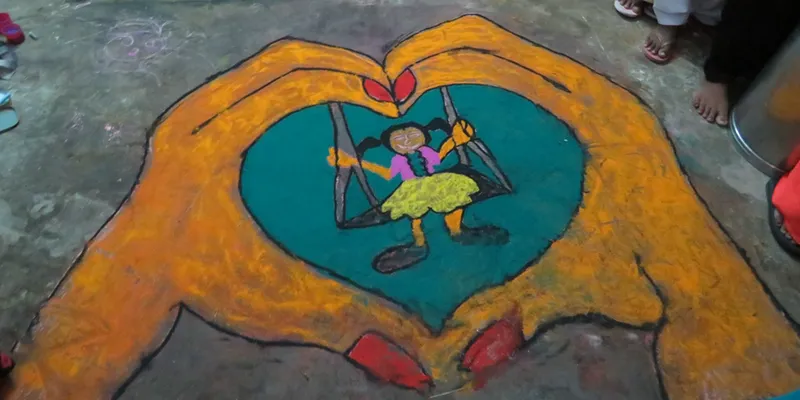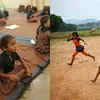[National Girl Child Day] How this organisation aims to help girls achieve their full potential
The Centre For Catalyzing Change, headed by Aparajita Gogoi, through modules and government collaboration helps girls and women by promoting gender equality, which it believes is essential for development and democracy.
In 2008, the Ministry of Women and Child Development and the Government of India marked January 24 to be celebrated as National Girl Child Day on January 24. This nationally observed day was initiated to raise awareness about the inequality that still persists in the country. Girls face challenges, sometimes even before they are born. From female foeticide, infanticide, discrimination in education, sexual abuse, child marriage, lack of reproducitve care and equal opportunities, girls and young women in the country have had to deal with tough times.

Artwork celebrating the National Girl Child Day. (Image source: C3)
However, just one day is not enough to spread awareness and tackle these issues, says Aparajita Gogoi with HerStory, Executive Director of Centre for Catalyzing Change (C3), an organisation focused on improving the condition of girls and women in the country.
Efforts must be taken everyday to break the cycle of oppression that many girls still face in the country. And work has to be done every day to ensure girls receive the resources that they deserve and achieve their full potential.
Helping girls achieve their full potential
For over three decades, C3 has been working in the country to “mobilise, equip, educate and empower girls and women to meet their full potential.” Beginning in 1987, at the core of its work is the belief that gender equality is essential for development and democracy.
“We primarily work around to make the lives of women and girls better. When it comes to adolescent girls, we work around building her agency, her life skills, so that her decision making power increases; her self-esteem, her self confidence increases so that she can negotiate a better life for herself,” says Aparajita.
She adds, “We specifically focus on girls completing 12 years of education atleast, and preventing child marriage. Then when the girl reaches her reproductive age, we work around ensuring that women and girls have access to information on family planning, contraception, and quality healthcare services. We try to work around the whole life cycle of a girl.”
How does this translate to on ground work?
Modules and curriculums are designed to be delivered to girls and women in areas where intervention is necessary. C3 also works in partnership with governments to design and deliver scaled-up programmes. Its in-school adolescent education programme, Udaan is now delivered at every government school in Jharkhand.

Girls take part in digital literacy class. (Image source: C3)
“We have two kinds of programmes. One is delivering these programs at scale. So we work through schools, Anganwadi centres, where we can reach maximum girls,” she explains . It leverages the public system, the government schools, and collaborates with the government in this method.
“Another method is to curate small programmes, such as offering scholarships to girls, where they can learn skilling or take karate classes. Or digital literacy courses where 3000-10,000 girls are learning digital skills. This is the kind of work where we still focus on the girl as an individual.” The organisation has a small grants program called Unniti, which is based on the philosophy of small philanthropy that has helped over 2000 girls.
Other programmes include Pahel, which empowers women politically; Youth Life, its digital education program for adolescents; and Do Kadam, an intervention program in Bihar for preventing domestic violence.
The organisations work has helped over 1.9 million girls in the last 30 years.
The changemakers
Several staff, community members, peer educators and volunteers are involved in bringing these modules to the girls. The organisation which predominantly works in rural areas, has a presence in five states in the country.
Aparajita believes that it’s these on-ground changemakers and their work needs to “acknowledged, recognised, and supported.”
In Bilaspur, Chattisgarh, community members provided C3 with free space to run itsdigital and financial literacy classes for adolescent girls. In Jharkhand, Suparna Chatterjee, a life skills teacher with C3, helped a girl continue her education after several teasing incidents made her think of dropping out. Poonam Guria, a teacher at Kasturba Gandhi Balika Vidyalaya (KGBV) in Ranchi has a secret box in her class where girls can ask any question. The questions range from relationship issues with parents to questions around sexuality, which she discusses openly in class. Her question box now gets 50 questions everyday.
Future plans
Aparajita outlines three priorities that C3 feels hold the key to its endeavours to help girls and young women. “One is to scale the model. We have added digital and financial literacy in some geographies. As the needs of young people change rapidly, the question is how do we keep these models relevant”
“The second is how can we take these cost-effective models to other states. Third is, how do we share what we are learning about programming to people in the sector, so that more people can work for women and girls,” she adds.
(Edited by Rekha Balakrishnan)


![[National Girl Child Day] How this organisation aims to help girls achieve their full potential](https://images.yourstory.com/cs/4/7951d870deb311e98c337d64c472c4c1/Imagek716-1579779429976.jpg?mode=crop&crop=faces&ar=2%3A1&format=auto&w=1920&q=75)






